Scam: Thieves equip ATMs with duplicate card readers and wireless cameras.
Example: [Collected via e-mail, January 2004]
Bank ATMs Converted to Steal IDs of Bank Customers
A team of organized criminals is installing equipment on legitimate bank ATMs in at least
front of the ATM (see photos). If you see an attachment like this, do not use the ATM and report it immediately to the bank using the
The equipment used to capture your ATM card number and PIN is cleverly disguised to look like normal ATM equipment. A "skimmer" is mounted to the front of the normal ATM card slot that reads the ATM card number and transmits it to the criminals sitting in a nearby car.
At the same time, a wireless camera is disguised to look like a leaflet holder and is mounted in a position to view ATM PIN entries.
The thieves copy the cards and use the PIN numbers to withdraw thousands from many accounts in a very short time directly from the bank ATM.
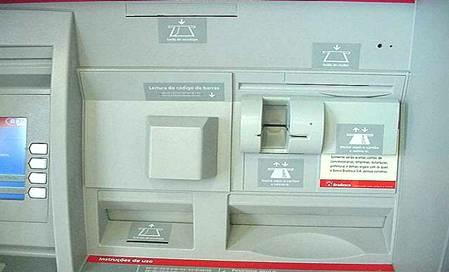 |
| Ordinary-looking ATM? |
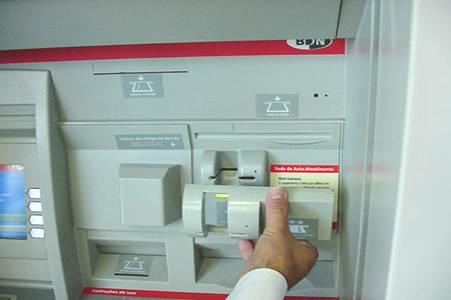 |
| A false card slot is affixed over the original card slot. The false slot holds an additional card reader used to copy card information. |
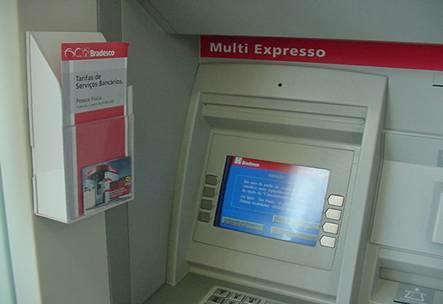 |
| An ordinary monitor and pamphlet holder? |
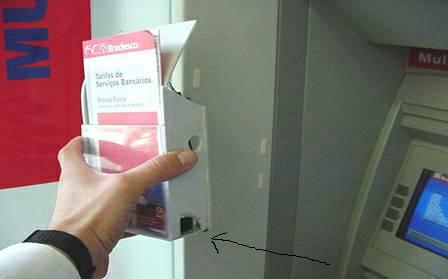 |
| The pamphlet holder houses a hidden micro-camera. |
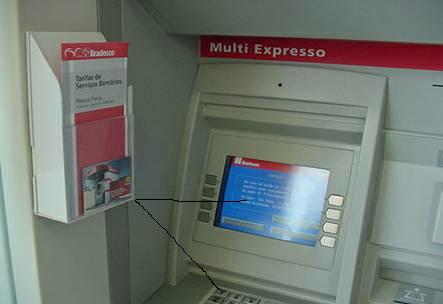 |
| The hidden camera is angled to view the monitor and the keypad and transmit wireless photos of them up to |
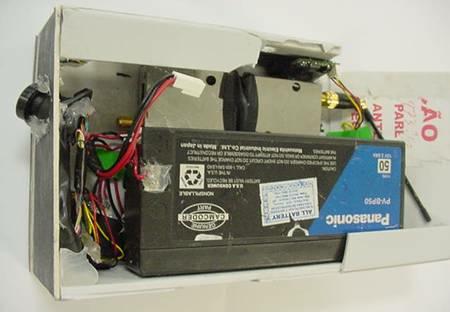 |
| The camera hidden in the pamphlet box includes its own battery and transmission antenna. |
Origins: Since the advent of the Automated Teller Machine (ATM) a few decades ago, banks and their customers have had to deal with a new form of theft: card-skimming. Card-skimming is the collection of ATM card numbers and PINs for the purpose of stealing money from bank accounts, a scheme accomplished through methods as low-tech as
simply watching customers as they use ATMs (a technique known as "shoulder surfing"), or methods as high-tech as installing false card readers (or whole false fronts) on top of existing ATMs. With the purloined information, scammers can manufacture counterfeit ATM cards and use them to withdraw money from accounts. (In some cases the thieves may steal the original ATM cards, then use some form of card-skimming to collect the appropriate PINs.)
The scheme described in the e-mail warning quoted above is one of the decidedly high-tech variety: a phony card slot installed over the real one scans information from an entered card's magnetic stripe, and a small camera hidden within an adjacent pamphlet holder records information from the ATM's display screen and keyboard. The pilfered information is sent via a wireless transmitter to waiting thieves, who can capture it on a laptop from up to
The very scheme pictured here was indeed used in South America to steal information (and money) from customers of Bradesco, a Brazilian bank:
A wireless transmitter inside the box then sends the video to the scammers, who can capture the information on a computer in a nearby car or building. The thieves can be up to A spokesperson for NCR, the ATM giant which produced the cash machine shown in the Police in Canada, the United States and Malaysia have reported cases of fraud using similar hi-tech methods.
An e-mail, which has been widely circulated in the past week, shows how a fake card slot containing a scanner can be attached to an ATM machine to record data from a credit or debit card's magnetic stripe. A camera attached to the side of the ATM and disguised as an information box is positioned to record information on the screen and the keypad.
Similar card-skimming equipment was also found on ATMs in Hong Kong in
Each camera, equipped with a transmitter and batteries, was hidden behind a fake panel affixed to the top of the ATM casing, a source said. The machines were at the bank's Tai Ho Road branch. The home-made panels were described by the source as highly sophisticated and not easily seen. They were very thin and only about 7cm high, matching the width of the ATMs and painted the same colour. The cameras were positioned to view the keypads and monitors of the machines to spy on cardholders as they entered their personal identification numbers. The devices are understood to have been able to transmit images to a remote receiver in the area and had been there for two or three days.
Two hi-tech pinhole cameras concealed in two automatic teller machines outside a branch of the Hang Seng Bank branch in Tsuen Wan were discovered when a repairman was fixing a blown fluorescent light, it was revealed yesterday.
In the United States, where independent ATMs (i.e., machines not maintained by banks) are more common, some crooks have resorted to even more thorough methods for stealing money. In
Skimming techniques can be used not only at banks and other ATM sites, but also at many point-of-sale locations (such as gas station pumps) where customers commonly use debit cards to pay for purchases. Although ADT announced in 2009 that they had developed a device to prevent card skimming, this form of fraud remains a concern for consumers. As recently as January 2010, a Boston area man was arrested for using cameras and a skimming device to steal over $100,000 from the accounts of bank customers.
Although other schemes (such as the introduction of
Additional information:
| | ATM Fraud: Banking on Your Money (MSNBC) |
Last updated: 1 February 2010
Sources: |
Lo, Clifford. "ATM Cameras Found by Chance." South China Morning Post. 9 January 2004 (p. 1). Shepardson, David. "Police Accuse Man of ATM Scheme." The Detroit News. 5 December 2003. Taylor, Neil. "Bank Customers Warned of Hi-Tech Thievery at ATMs." South China Morning Post. 16 December 2003 (p. 3). WBZ-TV [Boston]. "New Device Prevents ATM Skimming Thefts." 11 March 2009. WBZ-TV [Boston]. "Man Allegedly Ran Sophisticated ATM Skimming Scam." 28 January 2010.
